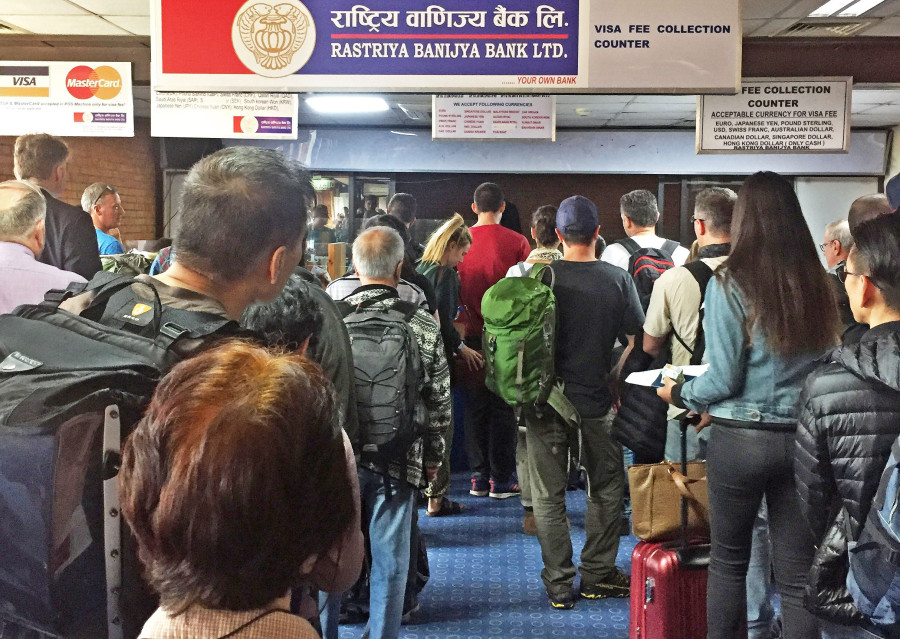National
At Nepal’s only international airport, it is not just the runway that needs fixing
The airport experience remains fraught with problems, beginning from the moment passengers exit the plane to the moment they leave the airport gates, as painfully slow processes take hours.
Thomas Heaton
Every time Suparna Mitra Bhattacharya arrives at the Tribhuvan International Airport from Kolkata, she expects chaos. Bhattacharya flies to Kathmandu often to visit her husband, who works in the city, and she has come to expect a less-than-professional experience.
“There are no clear marks for foreign and Indian passport holders. Neither is anyone clear about what counter or queue to approach,” said Bhattacharya. Then there’s the issue of post-immigration security and baggage claim, a part of the airport experience that is “even more horrible.”
“Newcomers to the airport will be totally confused about what exactly is going on,” she said. “At the end of the stairs, one bumps into a queue without any clue about what’s happening at the other end.” The security process is simply “very crude and annoying.”
Bhattacharya’s arrival experience at Nepal’s only international airport is not unique. A number of people the Post spoke to believe that the airport’s staff, amenities, immigration and security all need addressing. All of these concerns were outlined in a 2015 government report into the airport’s quality, but in the nearly four years since the report was published, not much has changed.
The airport experience remains fraught with problems, beginning from the moment passengers exit the plane to the moment they leave the airport gates, as painfully slow processes take hours. While the runway is finally receiving it’s long-overdue renovation because of delays and dangers associated with its derelict state—which has created its own issues around lengthy flight delays—the airport is soon to be transformed into a “boutique airport,” on April 14. With the “boutique” overhaul comes a long list of promised improvements.
Another woman, an Australian-born educator who has been living six months of each year in Nepal, says she has 12 years of experience in the international airport’s immigration lines.
“The immigration staff were the most rude people in Nepal, as usual,” she said, asking to remain anonymous. “Asking a question is painful, as they bark at you… It is cultural, I get it, I’m used to it from the type of people in these airport positions, but it’s a shame for tourists as they arrive thinking Nepali people are gruff.”
In February, airport staff reduced the Pokhara woman’s daughter to tears, when she filled out some paperwork wrong for a holiday in Indonesia, she said.
“A check-in staffer threatened to slap my crying 21-year-old Nepali daughter and lock her in a police cell upstairs at the airport because she had an incorrect paper and did not know what to do,” she said. Her daughter did not have everything correct, but, she says that “treating a naive young female in the manner he did is unacceptable”.
The staff are just one facet of the airport’s many problems, whether during departure or arrival. The woman has never used the computerised visa-on-arrival system because they are slow, the passport scanners hardly work and are often out-of-order, she said. She rather takes a pre-printed visa application and cash to the lines to avoid the computerised system. “I don’t mind the payment system, but it is a system that takes advantage of unsuspecting tourists with poor conversion or wrong change given,” the woman says.
While the visa payment system has improved in the 12 years that she had been coming to Nepal, as have hygiene standards, the staff’s attitude is still bad, as is security and baggage handling. There have been overall improvements in efficiency, but not as much as should have been over more than a decade, the woman said.

For long-time traveller Shweta Singh, the airport is “chaotic” and “embarrassing”.
“I try my level best not to have check-in luggage. It takes more than an hour to get my luggage sometimes,” said Singh, a Kathmandu-based training and development professional.
The Tribhuvan International Airport installed two new luggage carousels in 2016, promising that baggage would arrive within 45 minutes. But that promise has been empty, as the luggage continues to take a long time to arrive from the plane, and staff are forced to unload bags off the carousels to relieve congestion. The treatment of bags is also a concern, given that on her latest trip, Singh found her bag broken.
The time taken to get through immigration also varies greatly, depending on the number of flights arriving at any given time. Some get through quickly, while others are stuck for unnecessarily long periods.
“It’s a very bad joke, to be honest,” said Manuel Palz, a German NGO worker who has had trouble with immigration, which at times seems redundant given the level of attention to its security, he said.
While there are many security checkpoints for both departure and arrivals, none seem very effective, he says. Staff are inconsistent in their practices, deciding to impose rules on a whim, while the experience is also unnecessarily lengthy.
Palz is based in Kathmandu and has to travel frequently. “For some people, the tourists, it’s all fine and cool,” says Palz, who believes it might be novel for some. However, for a frequent flyer like him, it is just frustrating.
The recent changes in security on arrival, particularly relating to changes in duty-free allowances, have exacerbated the problem. While security has imposed duty-free restrictions of just one bottle, many are getting away with bringing alcohol in their checked luggage, said Palz.
The airport, however, has a plan to do something about its shortcomings, with its “boutique” scheme and its long-term plans, according to General Manager Raj Kumar Chettri. The short-term plan for the scheme primarily regards aesthetic changes, which should be “tentatively” completed within a year. Chettri said the airport will also have two more luggage carousels within the next seven months. Even now, however, the carousels are better than they once were, he said.
“You now get your bags within an hour of getting off the aircraft, before it took two or three hours,” said Chettri.
Issues around staff conduct have all but been solved, said Chettri. Staff throughout the airport have improved, as the “younger generation” are friendlier and better educated in customer service, he argued. “I don’t think [bad service] is happening nowadays,” he said. For complaints, however, he suggested people use the boxes placed throughout the airport or speak to the Terminal Duty Officer at baggage claim.
Immigration is “a problem that we have sorted out”, but the security lines have been difficult to address, said Chettri. “Our space is very limited. You have to be confined in that space. We are doing our best,” he said.
There were plans to extend the area, as part of the three-to-four year long-term plan, which also includes a new terminal building and an increase to the variety of amenities available to travellers, such as restaurants.
All this work will start from the beginning of the Nepali new year—on April 14–when the country’s prime minister will officially dub the airport “boutique” during a special ceremony.




 25.29°C Kathmandu
25.29°C Kathmandu














